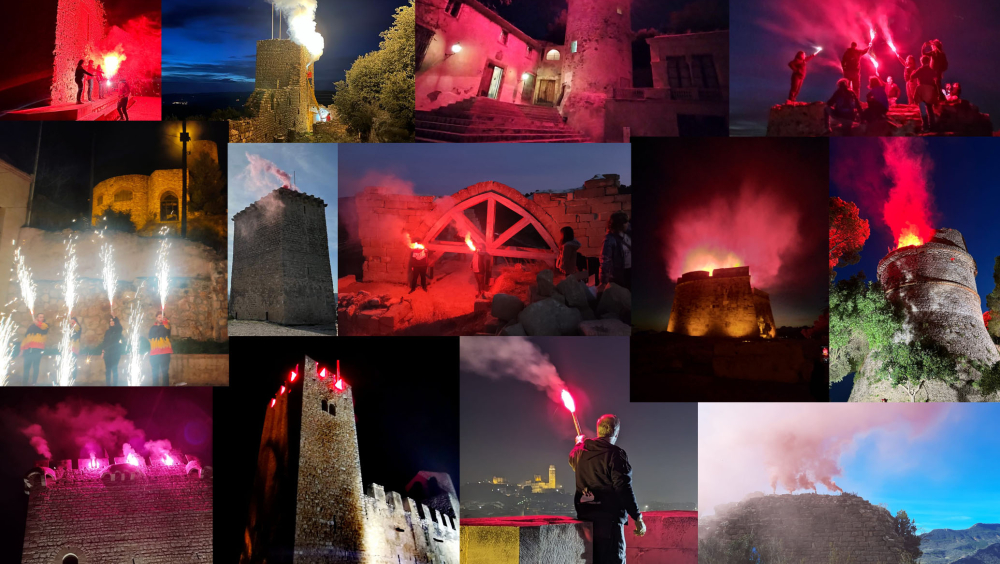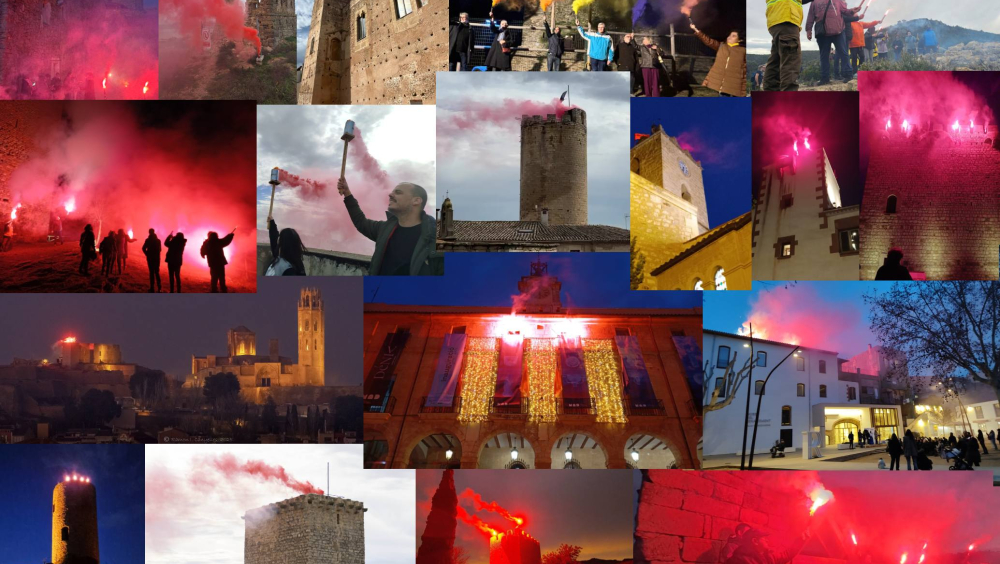Towers, Watchtowers, and Talayots of the Mediterranean for Human Rights: the case of Catalonia
Since 2022, the Ramon Muntaner Institute (IRMU) has been coordinating the participation of various watchtowers and other similar architectural defense elements in the Encesa Tower, Watchtower and Talayot Lighting project, which has been taking place in the Mediterranean since 2017 and is led from Mallorca.
In the case of those coordinated by the Ramon Muntaner Institute, there is the added value of giving great importance to the heritage element, and in most cases, the human rights-related advocacy is combined with activities to discover these towers, their history, the heritage itself, and the heritage of their surroundings. For this reason, many of the ENCESA's events include visits or lectures within their programs.
Likewise, the project has been linked to a research work carried out by the Western Mediterranean History Studies Group of the Department of History and Archeology of the University of Barcelona.
Every January, for the past nine years, the Lighting of Towers, Watchtowers and Talayots of the Mediterranean for Human Rights - Encesa has been held.
The origin of the action dates back to October 9, 2016, when a group of hikers returning from the Torre de Can Palou, above Tuent, in the municipality of Escorca, in Mallorca, recalled the old dream of making it possible to once again connect the defence towers that surround the island. Teachers from the IES Marratxí Secondary Education Institute set out to make it a reality. At that time, the fourth centenary of the death of Joan Baptista Binimelis was being commemorated, a mathematician and author of the signalling system (smoke and fire) that had been used since the 17th century to efficiently communicate possible attacks by pirates coming from the sea. For this reason, the Balearic Society of Mathematics SBM-XEIX also joined in the organization. The initial motive for this event was historical recreation: to return these unique architectural elements, for one day, to their function of visual communication. During the months of November and December 2016, the coordinators visited virtually every watchtower along the coast to verify their position. They then realized that the state of conservation of many of them was critical, and they added to their initial motivation a cry of alarm that could raise public awareness about the need to preserve this valuable heritage. Finally, faced with the humanitarian tragedy of the sea migration of so many people who have to flee their countries and who, in many cases, lose their lives during the crossing across the Mediterranean, it was decided to completely change the signal function, previously a danger warning, and imagine that the fire and smoke from the towers that day were actually beacons of welcome showing the way to safe harbor. This became the central motivation for the action.
The date chosen for the first edition was January 7, 2017, and two signals were established: a smoke signal just after noon and a light signal late at night. At each lighting, a manifesto would be read and the option to perform Lluís Llach's "Journey to Ithaca" together was offered. This has been the basic structure until now, to which other elements were added, such as visits to the towers, lectures, and musical performances.
Since that initial initiative, the project has grown and incorporated individuals, organizations, administrations, and territories. The Consell de Mallorca and, in particular, the Island Heritage Directorate have supported this initiative from the outset, providing support in the organization and coordination of events before and after the lighting, and continuing to the present day. Over the years, many other organizations have joined: the Cooperation Fund, Amnesty International, and the Ramon Muntaner Institute, among others.
The initiative has become an annual benchmark for rallying support for the defence of human rights. Each lighting point brings together various participating organizations each year, extending the event to the entire population. This creates a highly visual event denouncing the loss of life that occurs throughout the year in the Mediterranean, and collaterally, also calling for the protection and appreciation of the heritage of the watchtowers. The goal is for each lighting point to gather as many people as possible, generating community action, both in the preparation of the initiative and on the day of the activity, ensuring that the action expands and ultimately has the greatest impact. The objective is for the advocacy to not be a one-time event, but rather to raise awareness and generate interest in continuing it with other small actions throughout the year.
Since 2022, the Institut Ramon Muntaner (IRMU) has coordinated the project in Catalonia and collaborated with the lighting in the Franja (Aragon), Valencia, and Northern Catalonia (France). The IRMU's board of trustees includes the Department of Culture of the Generalitat de Catalunya, the Coordinator of Catalan Language Study Centers, and the Federation of Ateneus of Catalonia. The initiative also has the support of the Catalan Cooperation Fund, the Barcelona Maritime Museum, the Western Mediterranean Historical Studies Group - Department of History and Archaeology - University of Barcelona, and the Federation of Study Institutes of the Valencian Country, among others.
The IRMU's involvement in coordination aims to facilitate the incorporation of new points and expand this initiative to new territories by serving as a vehicle for the two fundamental motivations of the action.
In 2025, the event featured around 180 lighting points. This year's edition saw growing involvement from organizations and administrations at each location, as well as a larger turnout at the lighting. The organizations are increasingly diverse, in many cases linked to the defense of Human Rights, and this also helps to enrich the event and generate synergies that can provide continuity to sustained work throughout the year.
Finally, we would like to emphasize the fact that everyone can participate, whether through an organization or as an individual. The Institut Ramon Muntaner, around July, opens the possibility of registering for lighting points for the following year. Municipalities and organizations submit their proposals, and we subsequently inform anyone who wants to join about all the lighting points. Likewise, you can also act proactively and propose new lighting points in towns where it has never been held before. Simply raise the issue with the city council or a local association and submit a proposal. The Institut Ramon Muntaner (IRMU) helps you join. We can announce that in 2026, the Encesa will take place on January 31st.
We would like to close this letter by especially thanking all the organizations, study centers and institutes, federated athenaeums, associations, and all the city councils that have participated over the years. We encourage them to continue working together in the future and make Encesa possible for many more years to come, ensuring that the message we want to convey reaches more and more people.
The project takes place in different parts of the Mediterranean. The Towers are heritage sites built primarily in the 15th and 16th centuries with a clear defensive function, but the result of a community commitment. With the ENCESA project, they become beacons of harmony.
This is a heritage site that has been little studied and appreciated. The University of Barcelona project works in collaboration with universities in other countries to generate a shared methodology for documenting and studying the Towers.
Furthermore, many of these towers are visited during the European Heritage Days through activities programmed by various study centers, associations, and institutes, which then participate in ENCESA.

